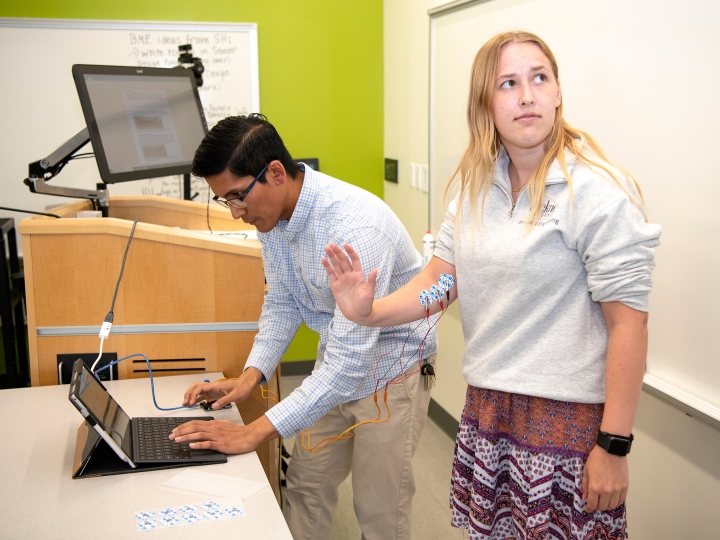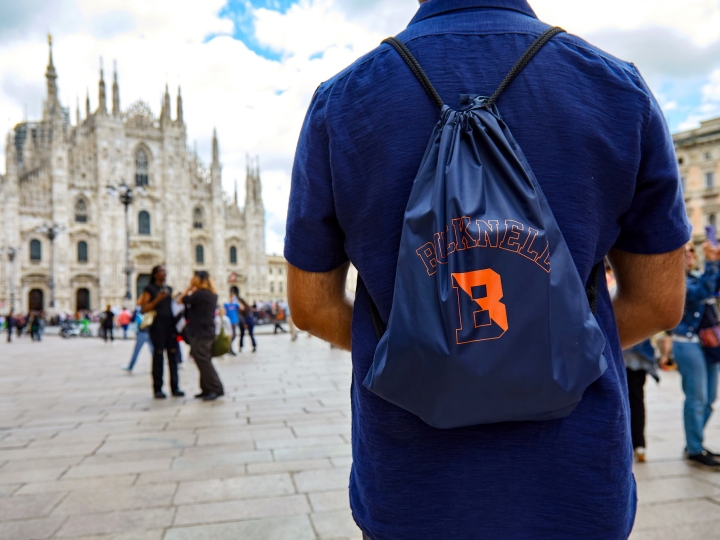
Bucknell Engineers Hit the Ground Running in Revamped ENGR 100 Course
April 1, 2022
While most Bucknell courses fall under an individual professor or academic department, ENGR 100 belongs to the entire college and exposes students to the diversity of the engineering field. Photo by Emily Paine
Real-world engineering doesn't happen in cavernous lecture halls.
It happens in small groups of creative and curious thinkers working together to solve engineering puzzles.
That's the Bucknell way, and this tight-knit collaboration starts not in year three or four but right in a student's first year.
"I recently got an email from a prospective student's parent asking about Engineering 100, our introductory course. They asked, 'Are your classes in these gigantic lecture rooms?' " says Professor Kat Wakabayashi, chemical engineering. "I was so happy to answer this question: No. We made a conscious effort to not do that. We really wanted the small community so they get this sense of belonging."
That email exchange demonstrated to Wakabayashi and his colleagues that their reimagining of the College of Engineering’s introductory course was off to a perfect start.
ENGR 100: Engineering Design Experience immerses students in hands-on, project-oriented assignments that help them experience multiple engineering disciplines and understand the ways they overlap.
"We are trying to adapt to the changing world," Wakabayashi says. "The world is becoming more diverse, more global and more interdisciplinary."

In each of the eight Engineering 100 sections, small student groups are presented with a problem to solve using engineering. Photo by Emily Paine, Communications
While most Bucknell courses fall under an individual professor or academic department, ENGR 100 belongs to the entire college. That meant updating the course required an interdisciplinary approach.
For the revamp, Wakabayashi teamed up with Professor Benjamin Wheatley, mechanical engineering, and Professor Kelly Salyards, civil & environmental engineering.
"We think this is an important time as they're walking into a major, perhaps on a whim or undeclared, to understand what the others do," Salyards says. "Engineers work with engineers, and it's important to know where to go when you need help."
Every semester, about 200 ENGR 100 students are divided into eight sections, each led by an engineering professor. Students within these sections split into small groups and are presented with a problem to solve using engineering.
The projects fall under a central topic, such as the 2021-22 theme of sustainability. One section designed a solar-powered building system, another tackled food waste and a third created a sustainability app.
"There are certainly some projects that are more mechanical engineering or more computer science," Wheatley says. "But at the end of the day, those projects are engineering."
While students explore interdisciplinary engineering in a meaningful and interactive way, they also learn the engineering design process — a set of steps that will guide their work at Bucknell and far beyond.
"Even after Bucknell and into my career, I can use that same process," says Chase Derk '25, a civil engineering major from Elysburg, Pa. "I can apply it to anything I do."

Throughout the course, students learn the engineering design process — a set of steps that will guide their work at Bucknell and far beyond. Photo by Douglas Kilpatrick
Other lessons from Engineering 100 take students beyond the world of engineering and into any career based around solving problems in creative ways — which is to say, every career out there.
A big lesson, Derk says, is that it's OK to fail. In fact, the classrooms and labs at Bucknell are a great place to learn that fact because students are surrounded by supportive peers and caring professors who can help them grow from these mistakes.
"We're probably not going to get it right the first time," Derk says. "We're going to make mistakes along the way. And this is a good way to make mistakes you can remedy and learn from."
This process doesn't happen in an impenetrable bubble. Because civil engineers like Derk practice working side by side with biomedical engineers like Olivia DeConinck '25 of Michigan, these Bucknellians will be ready to conquer challenges in a collaborative way.
"We could easily get a narrow-minded view," DeConinck says. "But if we get the chance to get together and share our own perspectives, that gives us all a bigger picture of what's out there."

